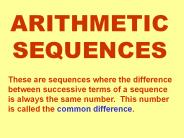9'2 Arithmetic Sequences - PowerPoint PPT Presentation
1 / 2
Title:
9'2 Arithmetic Sequences
Description:
... difference enables you to set up the calculation of the sixth term. ... enables you to insert a number of arithmetic means (averages) between two values. ... – PowerPoint PPT presentation
Number of Views:52
Avg rating:3.0/5.0
Title: 9'2 Arithmetic Sequences
1
9.2 Arithmetic Sequences
Arithmetic sequences are sequences with a common
difference between any two successive
terms. These sequences are defined recursively
by ak1 ak d where d ak1 -
ak Basically, the next term is found by taking
the current term and adding the common
difference. If given an unclassified
sequence, it can be proven as arithmetic if a
common difference between all successive terms
can be shown. 1,4,7,10, , 3n - 2 d ak1 -
ak 3(k1) - 2 - (3k-2) 3k 3 - 2 - 3k 2
3 Since there is a constant difference between
any two successive terms, this sequence can be
classified as arithmetic. Once a sequence is
known to be arithmetic, you can use the following
formula to find successive terms an a1
(n-1)d This formula states that the nth term of
an arithmetic sequence can be found by taking the
first term and adding the common difference one
less than n times. Find the fifteenth term of
the arithmetic sequence a1 20, a2 16.5, a3
13 d a2 - a1 16.5 - 20 -3.5 a15 a1
(15-1)d 20 (14)(-3.5) -29 Find the
sixth term of the arithmetic sequence a4 5, a9
20 5 a1 3d 20 a1 8d -15 -5d The
common difference is 3, which can be used to
trace back from the fourth term to the first term
of -4. Knowing the first term and the common
difference enables you to set up the calculation
of the sixth term. a6 a1 (6-1)d (-4)
(5)(3) 11 If given the right information,
this approach can be used to create a function
for the nth term of an arithmetic sequence Find
the nth term of the arithmetic sequence 16,13,10,
7 an a1 (n-1)d an 16 (n-1)(-3) an 16 -
3n 3 19 - 3n
2
The partial sum for arithmetic sequences can be
calculated with the following formula Sn n/2
2a1 (n-1)d By splitting the 2a1, this
equation can be rewritten as Sn n/2 a1 a1
(n-1)d. Because a1 (n-1)d equals an, the
formula can be simplified to Sn n/2 (a1
an). Find the sum of the first twelve terms of
the arithmetic sequence defined by f(n)
7-4n a1 7 - 4(1) 3 a12 7 - 4(12)
-41 Therefore, the sum is calculated as S12
12/2 ( 3 (-41) ) 6 (-38) -228 To
simplify an expression, a sum can be written in
summation notation 1/4 2/9 3/14 4/19
5/24 6/29 6 This is the sum
of 6 terms, so it will be simplified to S.
n1 The numerators have a common
difference of 1. This results in the equation of
an 1 (n-1)(1). Therefore, an n. The
denominators have a common difference of 5. This
results in the equation of an 4 (n-1)(5).
Therefore, an 5n - 1. 6 This
sum can be rewritten as S n / (5n - 1).
n1 Understanding arithmetic sequences
enables you to insert a number of arithmetic
means (averages) between two values. Insert an
arithmetic mean between 3 and 7. 3 , __ , 7 The
arithmetic mean in this case can be easily
calculated as (3 7) / 2 or 5. This results in
an arithmetic sequence of 3, 5, 7. Insert
three arithmetic means between 2 and 9. 2 , __ ,
__ , __ , 9 This task requires you to imagine an
arithmetic sequence with a1 2 and a5 9. To
do this, you must follow the definition a5 a1
(5-1)d. This results in 9 2 4d, where the
common difference between terms must be 7/4.
Adding 7/4 from term to term results in the
sequence 2, 15/4, 22/4, 29/4, 9.






























